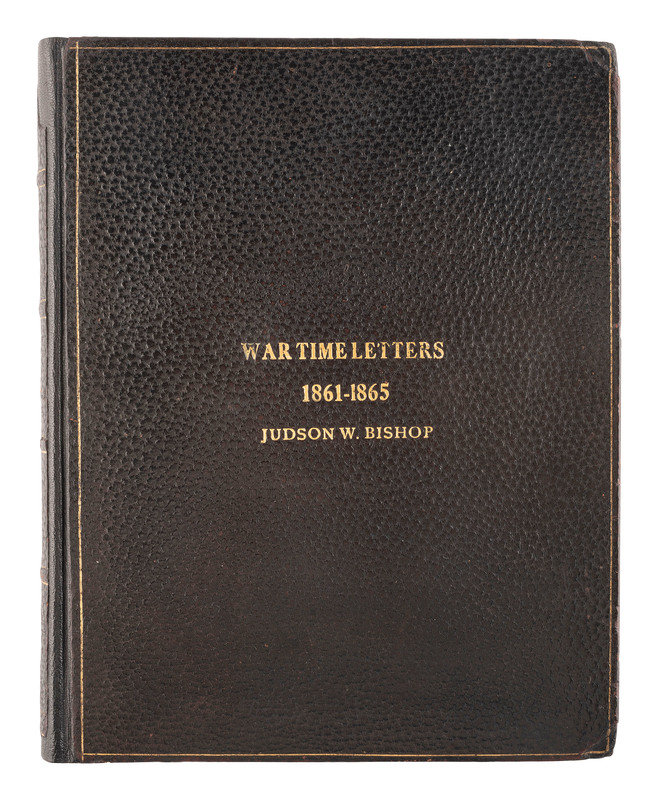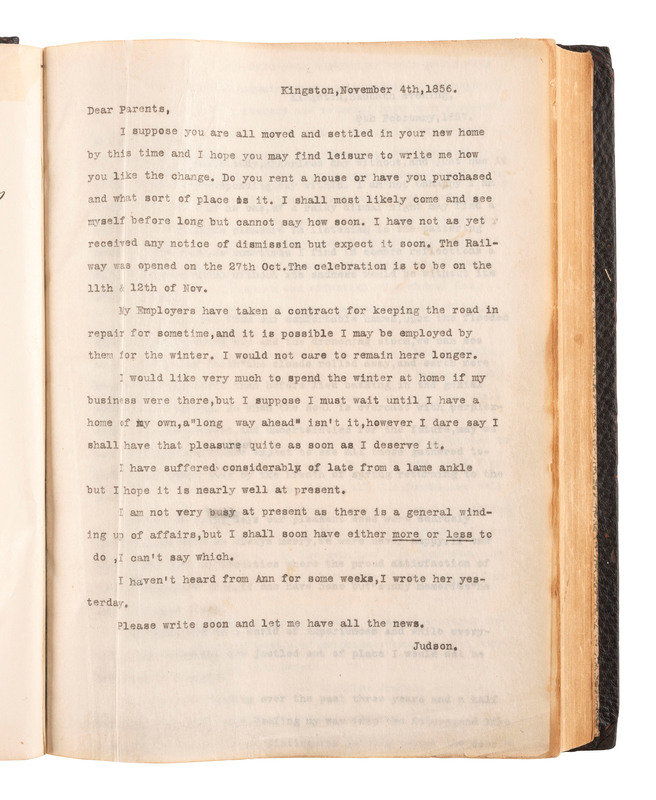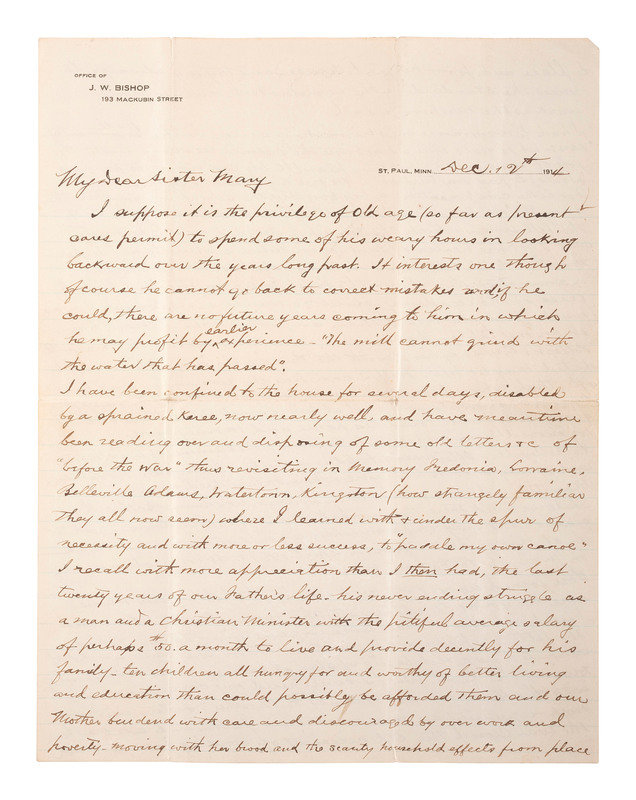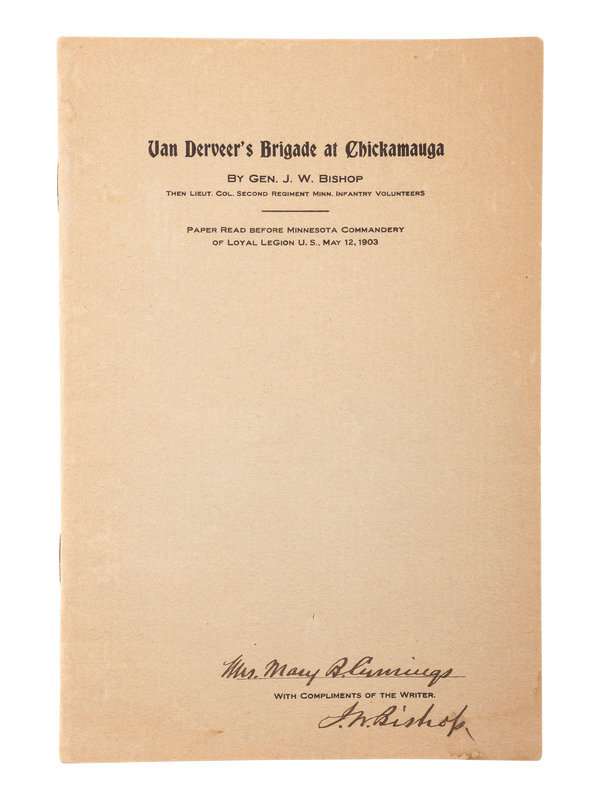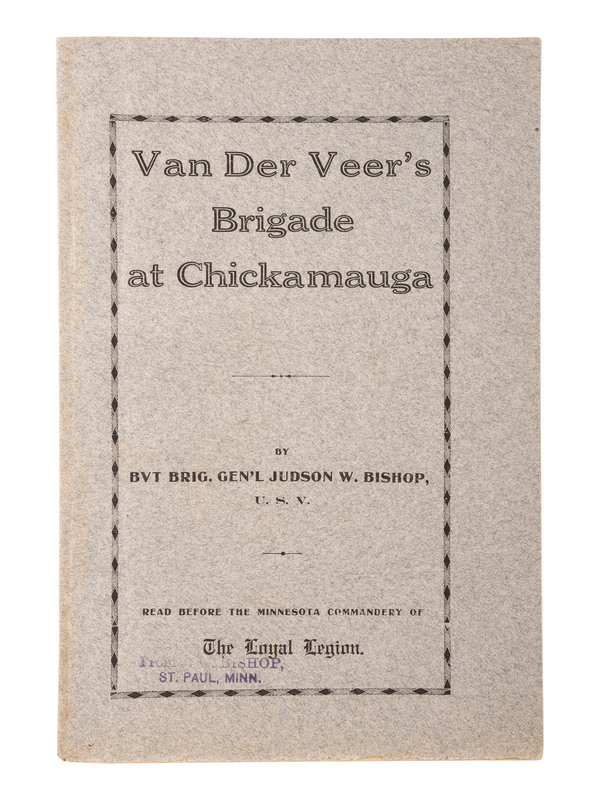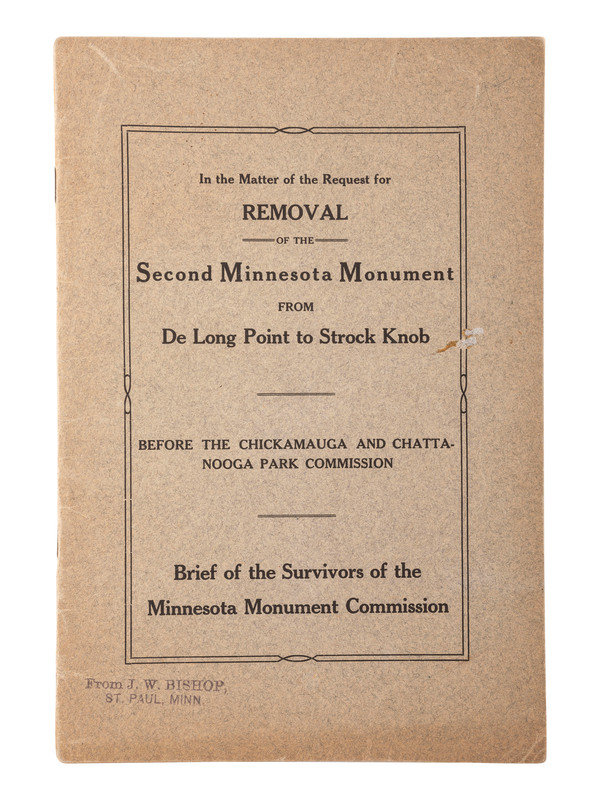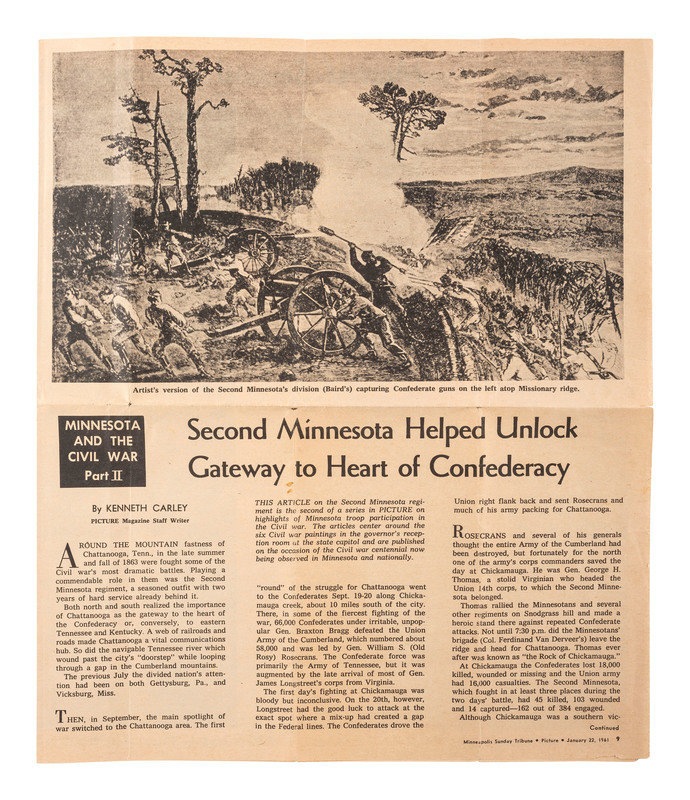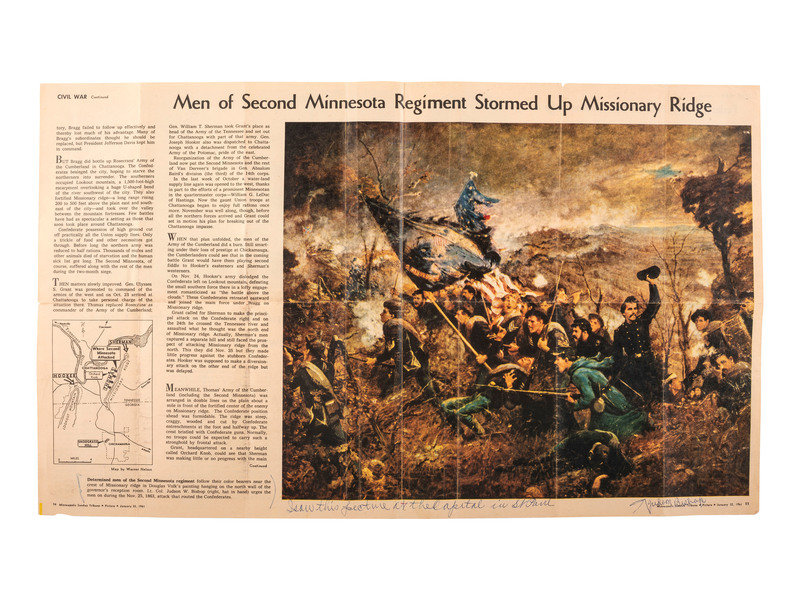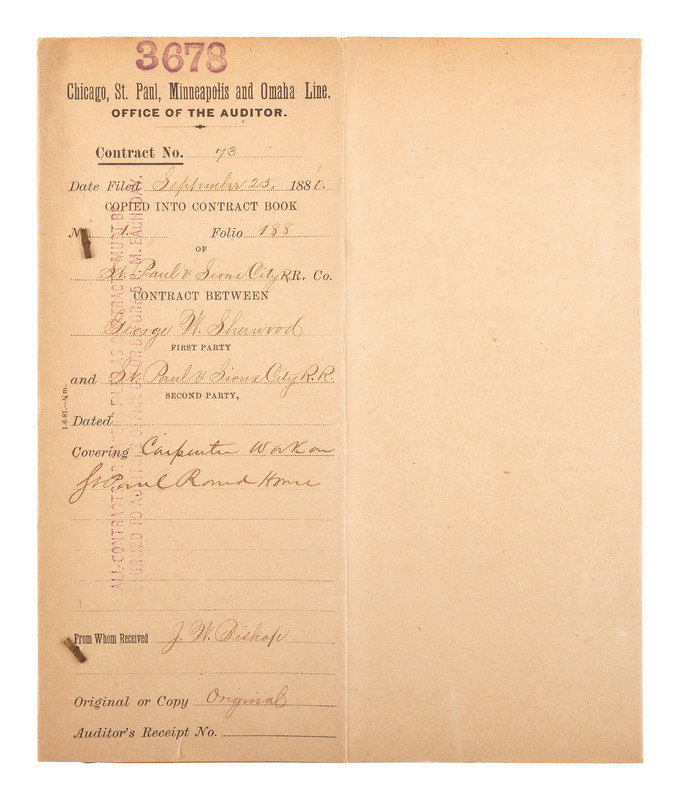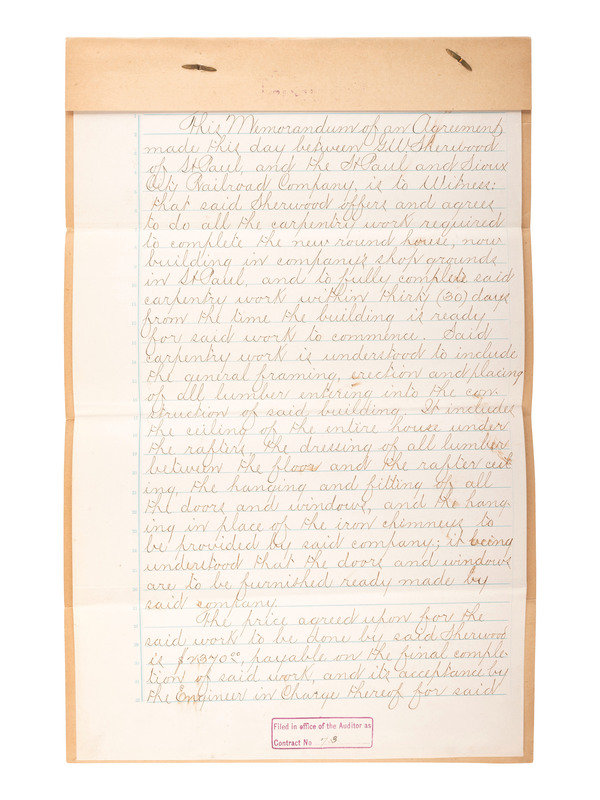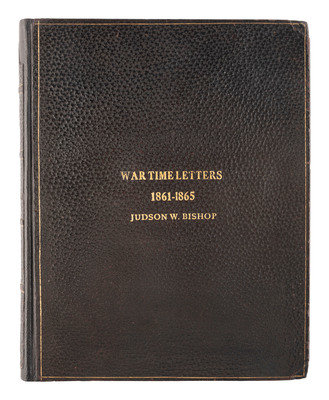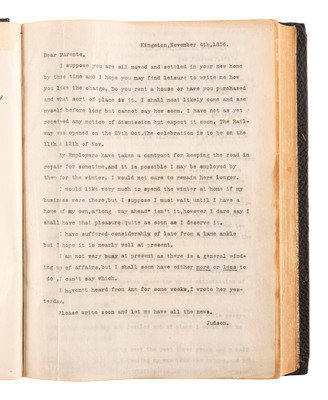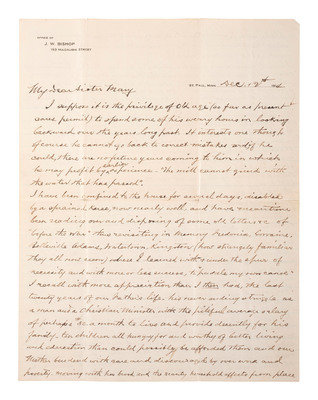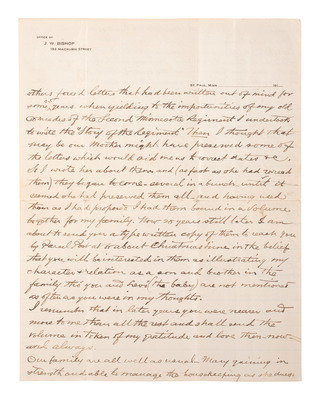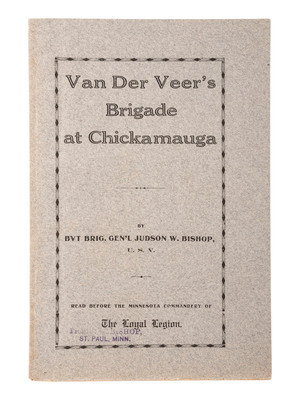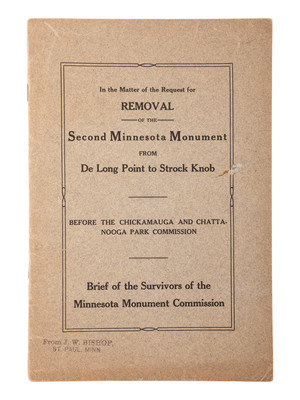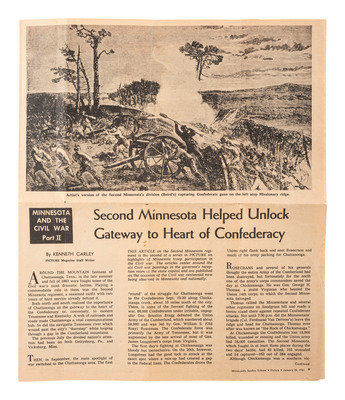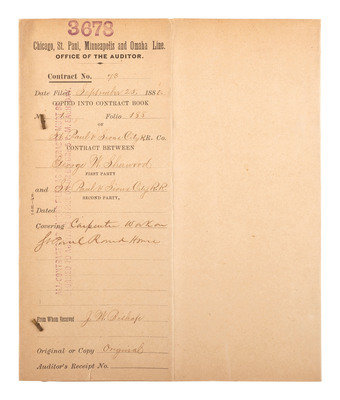Condition Report
Contact Information
Lot 818
[CIVIL WAR]. Judson W. Bishop, 2nd Minnesota Infantry, Civil War archive incl. typed transcription of letters dating from 1861-1865 and related documents.
Sale 1096 - American Historical Ephemera & Photography
Lots Open
Nov 11, 2022
Lots Close
Nov 21, 2022
Timed Online / Cincinnati
Own a similar item?
Estimate
$300 -
500
Price Realized
$188
Sold prices are inclusive of Buyer’s Premium
Lot Description
[CIVIL WAR]. Judson W. Bishop, 2nd Minnesota Infantry, Civil War archive incl. typed transcription of letters dating from 1861-1865 and related documents.
BISHOP, Judson Wade (1831-1917). War Time Letters, 1861-1865. Bound typescript of 127 letters, ca 1916. 4to. With ca 1916 image of Judson Bishop in GAR uniform tipped in to front flyleaf. (Toning to page edges, occasional creasing.) Contemporary dark brown morocco gilt (rebacked). INSCRIBED BY JUDSON to his sister Mary, dated 25 December 1916. Includes 127 letters written by Judson primarily to his family, with 2 pre-war letters but the rest written during Bishop's service in the Civil War.
[With:] BISHOP, Judson Wade. Autograph letter signed ("Judson"), to his sister Mary. [St. Paul, MN], 12 December 1914. 4 pages, 4to, old creases with some toning. With typed transcription of full letter. A letter to his sister presenting the bound letters.
[With:] BISHOP, Judson Wade (1831-1917). Van Derveer's Brigade at Chickamauga. [Minnesota?]: [Loyal Legion?], [1903]. SIGNED BY THE AUTHOR. -- BISHOP, Judson Wade. Van Der Veer's Brigade at Chickamauga. [Minnesota?]: [Loyal Legion?], [1903]. -- In the Matter of the Request for Removal of the Second Minnesota Monument from De Long Point to Strock Knob. Before the Chickamauga and Chattanooga Park Commission. [Minnesota?]: N.p., ca 1911. -- Together, 3 pamphlets, 8vo.
[Also with:] 15 photocopied pages related to Bishop from the National Archives. -- 3-page typed biography of Judson Wade Bishop. Madeline Island, [WI], 1916. -- CARLEY, Kenneth. Second Minnesota Helped Unlock Gateway to Heart of Confederacy. Minneapolis Sunday Tribune, 22 January 1961. 4-page article. -- BISHOP, Judson Wade and G.W. Sherwood. Manuscript labor agreement between signed ("J.W. Bishop" and "G.W. Sherwood"). A labor agreement G.W. Sherwood and the St. Paul and Sioux City Railroad Company, signed by Bishop.
Archive of Judson Wade Bishop, a former colonel and commander of the Second Minnesota Volunteer Infantry during the Civil War. The archive begins with a four-page handwritten letter from Bishop to his sister Mary Bishop Cumings, dated 14 December 1914. He explains that he wrote his mother in 1890 asking if she had saved any of the letters he wrote home to his family during the conflict, as he was putting together a history of his regiment (The Story of a Regiment, 1890). When his mother sent him what she had, he was surprised that she had kept all of his correspondence - which was of considerable help in writing the unit’s history.
It is these letters that form the bound typescript, as he had his daughter Janette type up his Civil War family correspondence in 1914. He then had them bound together to give to his sister Mary as a Christmas present.
Judson Bishop’s volume of letters describes the history, marches, and battles of the Second Minnesota, one of the elite fighting regiments of the Western theater in the Civil War. During its service to the Union, the Second Minnesota fought in the Battles of Mill Springs, Perryville, Chickamauga, Missionary Ridge, Resaca, Kennesaw Mountain, and Bentonville, as well as the sieges of Corinth and Atlanta. In addition, it took part in Sherman’s famous March to the Sea and his later campaign in the Carolinas. Since Bishop served with the unit from the day of its formation until the day it was dissolved, every skirmish, battle, and movement is covered in the letters that he dutifully sent home to his family. His style is straightforward, quick-witted, and vivid, always providing geographic details allowing for a complete narrative of the regiment.
He is not shy about describing the scenes and dangers of the battlefield, including the pounding of the cannons and the number of dead and wounded. After the Battle of Perryville, Bishop writes on 13 October 1862, that “Our Reg’t deployed to its position in a perfect storm of shot and shell…the balls came constantly crashing through the trees, or heaving up the earth and stones...or whistling over our heads with a rushing noise which to my ears was more suggestive of danger than either of the other styles of approach.” (pp. 110-111) Later in a letter from 5 July 1863, he describes “a stretcher with a poor bleeding soldier in it, dressed in the rebel grey, a pale, smooth face as handsome as a girl’s is turned up to the dripping sky, and his life’s blood is oozing from a red spot on his breast. 'Shot through the body, cannot live an hour,' says the surgeon.” (pp. 195-96)
And at the bloody Battle of Chickamauga in September 1863, Bishop writes two long letters describing the carnage, reporting that “at 10 our Brigade was sent for in hot haste and we moved forward and in the terrible storm of death just in time to save the ground from which the rebels in overpowering numbers were pressing back our lines. The shot and shell and grape came tearing and crashing through the trees just over our heads but the musket balls came thick as hail stones and being better aimed did most of the deadly work. We had not been under fire 3 minutes…when every mounted officer in our regiment …had his horse shot under him. My beautiful Betty was shot in two places. We soon got into position and opened fire in return, and for about ten minutes, every minute seeming an hour, the two opposed Brigades faced each other and death…Our Brigade fixed bayonets and charged across the field, driving the rebels back into the woods…the rebels broke and fled….Before my horse was shot, I had one bullet [pass] through my pants near my ankle and two had struck the scabbard of my saber. It seemed as if by holding up my hand I could have caught it full of bullets in a moment, such was the singing they made. Without giving us time to gather up our wounded we were ordered away a mile or more to support our forces who were being overwhelmed and driven back...at 2:30 the rebels attacked us. They were repulsed with terrible loss but renewed the attack again and again with fresh troops until the afternoon wore away and darkness found us still in possession of the ridge.” (29 September 1863, pp. 208-209)
Bishop always provides descriptions of the towns that his regiment passes through and the people he encounters along the way, supplying the reader with a sense of the turmoil, hardships, and sacrifices that the war imposed on the civilian population. There are also personal stories and anecdotes he relates that never make it to the history books, including the flirting of the Southern belles with Judson and other Union officers, the capture of a rebel major while he is in bed; the clapping and cheering of a Southern family when a group of Southern guerrillas ambush and kill a Union colonel, and the reaction it evokes from the Federal troops.
This lot is located in Cincinnati.

